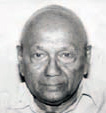Hector Abhayavardhana facts for kids
Quick facts for kids
Hector Abhayavardhana
|
|
|---|---|
 |
|
| Born | 5 January 1919 Kandy, Sri Lanka
|
| Died | 22 September 2012 (aged 93) |
| Nationality | Sri Lankan |
| Occupation | Theoretician |
Hector Abhayavardhana (born January 5, 1919 – died September 22, 2012) was an important thinker and political leader from Sri Lanka. He was a long-time member of the Lanka Sama Samaja Party (LSSP) and helped start the Bolshevik-Leninist Party of India, Ceylon and Burma. He was known for his ideas and writings on politics.
Contents
Early Life and Education
Hector Abhayavardhana was born in Kandy, Sri Lanka. His family was part of the colonial middle-class, meaning they had adopted many British customs and ways of life. He went to school at St Thomas' College, Mt. Lavinia.
When he was 15, he decided to become an atheist, meaning he didn't believe in God. In 1936, he joined University College, Colombo. There, he studied liberal arts and met teachers who had ideas about Marxism, a way of thinking about society and economics. He later studied law at the Colombo Law College.
First Steps in Politics
Hector's first experience with political action was the Bracegirdle incident in 1937. This was when the government tried to send away an Australian worker who was helping local laborers. Hector attended a big meeting where this worker made a powerful speech. This event made him think more about fairness and independence.
He also helped organize a debating society in Mount Lavinia. This group invited important speakers like Dr. Colvin R. de Silva to discuss different ideas.
Becoming a Revolutionary
In 1940, Hector joined the Lanka Sama Samaja Party (LSSP). This party was working for Sri Lanka's independence from British rule. When the party leaders were put in prison, Hector helped them escape to India. He even disguised himself as a priest to travel safely!
In India, he joined another political group called the Bolshevik-Leninist Party of India, Ceylon and Burma (BLPI). He started writing important political essays, sharing his ideas about how to achieve independence. His writings were considered very influential.
Working as a Journalist
After World War II, Hector stayed in India for a while. He worked as a journalist and editor for several newspapers and magazines. He wrote for New Spark in Bombay and later moved to Chennai. He also became the General Secretary of the Socialist Party in India.
He then moved to New Delhi, where he edited Socialist Appeal and wrote for the Hindustan Standard. He spent time in Hyderabad editing another magazine called Mankind before returning to New Delhi to start his own critical journal, Maral.
Return to Sri Lanka and Later Life
In 1959, Hector Abhayavardhana married Kusala Fernando and returned to Sri Lanka in 1960.
He played a key role in forming alliances between different political parties in Sri Lanka. He helped the LSSP work with the Sri Lanka Freedom Party (SLFP) and the Communist Party of Sri Lanka. These parties eventually formed a group called the United Front in 1968.
Hector became the editor of The Nation, an English newspaper for the United Front. When the United Front formed a government in 1970, Hector became the Chairman of the People's Bank. After the United Front broke up in 1975, he started another newspaper called Socialist Nation. He was also a long-standing member of the LSSP's main decision-making body, the Politburo.
In 1992, Hector Abhayavardhana was honored at the 50th anniversary celebration of the Quit India movement in New Delhi. This showed how important his work in the independence movements was.
Works
- Hector Abhayavardhana, Selected Writings, Colombo, Social Scientists Association, 2001.

